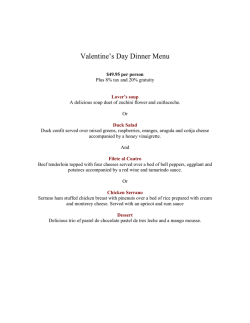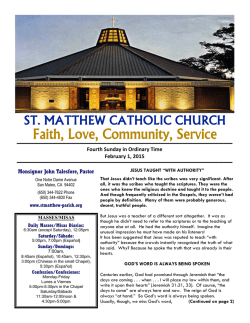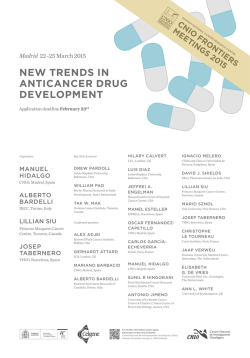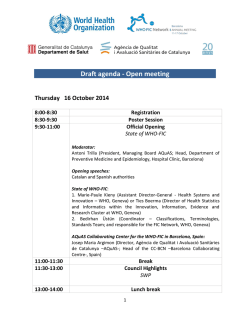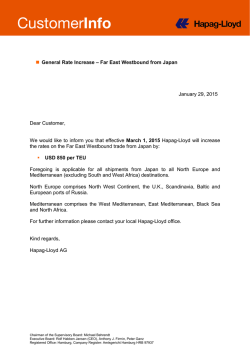
Miguel-Ángel Mateo CURRICULUM VITAE
Miguel-Ángel Mateo CURRICULUM VITAE February 2015 Table of Contents PERSONAL INFORMATION 2 ACADEMIC BACKGROUND 2 LANGUAGES 2 PROFESSIONAL BACKGROUND 3 CURRENT RESEARCH INTERESTS 4 MAIN RESEARCH PROJECTS 4 RELEVANT PUBLICATIONS 7 RELEVANT CONTRIBUTIONS TO CONFERENCES 10 LECTURING 12 ADVISING 12 C.V. MIGUEL ÁNGEL MATEO, FEBRUARY 2015 PERSONAL INFORMATION Second name: First names: Date of birth: Place of birth: Professional address: Mateo Miguel-Ángel 22-January-1965 León, Spain Centro de Estudios Avanzados de Blanes, Consejo Superior de Investigaciones Científicas. Acceso a la Cala St. Francesc, 14. 17300 Blanes, Girona, Spain. Tel. +34 972 336101; Fax. +34 972337806. E-mail: [email protected] Web site: http://161.111.254.94/GAME/WEB_MATEO/Home.html Skype: miguel.calling ACADEMIC BACKGROUND 1984-1989. Degree in Biological Sciences, Barcelona University, Spain 1989-1995. Ph. D. in Biological Sciences (specialised in Aquatic Ecology), Barcelona University, Spain. Title: 'Dynamics of the detritic compartment in two Mediterranean seagrasses'. Supervisor: Dr. Javier Romero. Defence opponents: L. Mazzella (seagrass ecologist, Stazione Zoologica di Napoli), M. Hemminga (seagrass ecologist, Netherlands Institute of Ecology), Dr. J. Ros (Benthologist, Barcelona University), Dr. M. Zabala (Bentologist, Barcelona University), L. Tapia (Plant ecophysiologist, Barcelona University). LANGUAGES (Level of knowledge: H, high; M, medium; L, low) Spanish Catalan English French Italian Dutch Mother tongue Second mother tongue Spoken H H M L Read H H M L Understood H H M L Written H L L L 2 C.V. MIGUEL ÁNGEL MATEO, FEBRUARY 2015 PROFESSIONAL BACKGROUND 2015-2017 Member of the Publications Committee of the Association for the Science of Limnology and Oceanography. 2014-2017 Member-At-Large of the Association for the Science of Limnology and Oceanography. 2013-2016 Adjunct professor at Edith Cowan University, Perth, Australia. 2008- Staff researcher at CSIC-CEAB. Roles at the CEAB: (i) Head of the Group for Aquatic Macrophyte Ecology (GAME); (ii) Head of the inorganic and organic chemistry laboratories; (iii) CEAB Staff Secretary. 2004-2008. Contracted senior researcher at CSIC-CEAB (Spanish Council for Scientific Research – Centre for Advanced Studies). 2002-2004. Associate Professor in Ecology (tenure track position), Ecology Department, Barcelona University, Spain. 2001-2002. Associate Professor, Ecology Department, Barcelona University, Spain. 1999-2001. Return contract (PB97-0865), Spanish Government, Plant Physiology Department, Barcelona University, Spain. 1999-1999. Research contract. 'Combining dating and stable carbon isotope analysis in the Mediterranean seagrass Posidonia oceanica: an assessment of the potential for paleo-reconstruction'. Netherlands Institute of Ecology, Centre for Estuarine and Coastal Ecology, The Netherlands. 1997-1998. Associate Professor, Ecology Department, Barcelona University, Spain. 1995-1997. EU-Post-Doc Marie Curie fellow (MAST-MAS2-CT-94-5022). 'Carbon limitation and seagrass regression: a study based on the stable isotopes of carbon'. Netherlands Institute of Ecology, Centre for Estuarine and Coastal Ecology, The Netherlands. 1992-1994. EU-research contract. 'Elements stocks and fluxes in the Posidonia oceanica ecosystem of the Mediterranean'. Science and Technology for Environmental Protection (STEP-PL-900-254). Barcelona University, Spain. 1989-1992. EU-research contract. 'A functional approach to the Posidonia oceanica ecosystem'. International Research Program (EV4V1-0091). Barcelona University, Spain. 3 C.V. MIGUEL ÁNGEL MATEO, FEBRUARY 2015 CURRENT RESEARCH INTERESTS 1. Ecology and biogeochemical cycles associated to seagrass-dominated ecosystems. 2. Long-term carbon accumulation in seagrass ecosystems. 3. Palaeoecological approach to the ecosystem of Posidonia spp based on the study of its pluri-millenarian peat-like deposits. 4. Application of isotopic techniques to ecophysiological studies in seagrasses. 5. Change in Ecology. MAIN RESEARCH PROJECTS (Original titles of projects and names of institutions have been translated into English) Date. 'Project title'. Project leader. Funding Institution. Other project information. 2015-2017 ‘Millenary changes in the ecosystems of insular National Parks: perturbations, resilience, and trends after the seagrass archives’. Miguel A. Mateo. Autonomous Organism of Spanish National Parks. Project Reference: 1104. 2014-2017 ‘Advances in sampling techniques, biogeochemical characterization, and quantification of the millenary deposits of seagrasses’. Miguel A. Mateo. Spanish National Research Plan. Project Reference: CTM2013-47728-R. 2014-2016 ‘Assessing the capacity of seagrass sediments to sequester carbon dioxide and metal pollution: past, present and future scenarios’. Paul Lavery. ECU-Industry Collaboration Scheme. Edith Cowan University, Perth. 2012-2014 ‘Blue-Carbon stores in Australia's seagrass ecosystems - how much and how variable?’ Paul Lavery. AINSE (Australian Institute of Nuclear Science and Engineering. 2012-2014 ‘Protection of coastal ecosystems and marine natural resources’. Paul Lavery. Commonwealth of Australia (Department of Innovation, Industry, Science sand Research), Collaborative Research Networks (CRN) Program: CRN2011:05. 2011-2012 ‘Carbon preservation in seagrass ecosystems - characterising Australia's BlueCarbon reserves’. Paul Lavery. AINSE (Australian Institute of Nuclear Science and Engineering): ALNGRA12 011P. 2010-2012 ‘The role of Mediterranean seagrasses in the global carbon cycle. Miguel A. Mateo. Spanish Council for Scientific Research: 200930I114. 2009-2010 ‘Assessment of the ecological impact of the extreme storm of Sant Esteve’s Day (26 December 2008) on the littoral ecosystems of the north Mediterranean Spanish coasts’. Miguel A. Mateo. Spanish Council for Scientific Research: PIEC 200430E599. 2006-2010 ‘The carbon sink associated to marine macrophytes and development of its potential in palaeoecology and environmental management (II)’. Miguel A. Mateo. Spanish Ministry of Education and Science: CTM2006-12492/ MAR. 4 C.V. MIGUEL ÁNGEL MATEO, FEBRUARY 2015 2005-2008 ‘Sustainable management of the Mediterranean coastal fresh and transitional water bodies: a socio-economic and environmental analysis of changes and trends to enhance and sustain stakeholders benefits’. Miguel A. Mateo. European Union INCO funding Scheme: INCO-CT2005-015226. 2005-2007 ‘Sizing the sink under the seagrass Posidonia oceanica and exploring its palaeoecological potential’. Miguel A. Mateo. Spanish Council for Scientific Research; Pioneering science funding scheme: CSIC-PIF2005: 200530F0230. 2005-2007 ‘The importance of beach-cast macrophytes as trophic resources to wrackinhabiting arthropod species of Mediterranean sandy shores’. Miguel A. Mateo. Spanish Council for Scientific Research/ Italian National Research Centre: 2004IT0026; Agreement: 01IT0001. 2005-2007 ‘The carbon sink associated to marine macrophytes and development of its potential in palaeoecology and environmental management (I)’. Miguel A. Mateo. Spanish Ministry of Education and Science: CTM2005-00132/ MAR. 2002-2005 ‘Posidonia oceanica millenarian deposits: first approach to the palaeoecology of a marine phanerogame during the recent Holocene' Miguel A. Mateo (Univ. Barcelona). Spanish National Research Programme: CICYT BOS2002-02247. 2002-2004 ‘Effects of nutrient release from Mediterranean fish farms on benthic vegetation in coastal systems’. Marianne Holmer, National Environmental Research Institute, Denmark (European Union: QLRT-2000-02456). 2002-2004 ‘From the river catchment areas to the sea: comparative and integrated approach to the ecology of Mediterranean coastal zones for sustainable management' (European Union, INCO: MED-CORE, ICA3-2001-10028). Felicita Scapinni (Univ. of Firenze). 2002-2004 'Reconstruction of crop environmental conditions at the beginning of agricultural practices based on the analysis of archaeological material from cereals' (Spanish Ministry of Science and Tecnology. BTE2001-3421-C02-01). José Luis Araus (Univ. of Barcelona). 1999-2001 'Study of the potential of isotopic techniques as selection criteria in strategies of genetical improvement in cereals'. José Luís Araus. Spanish Government. Frame project: 'Increase in the eficiency of the genetic selection in cereals for espanish field conditions: physiological parameters' (CICYT PB97-0865), Spain. 1999-2001 'Carbon balance in the seagrass Posidonia oceanica: inter-annual fluctuations, consequences at the ecosystem level, and use for environmental management and diagnosis'. Javier Romero. Spanish Government (CICYT MAR98-0635), Spain. 1997-1999. 'Monitoring net of the biological quality of catalan seagrass meadows'. Javier Romero. Agriculture, Farming, and Fisheries Council, Catalan Regional Government. Spain. 5 C.V. MIGUEL ÁNGEL MATEO, FEBRUARY 2015 1996-1997. 'Study of Benthic and water column production in the Ebro river estuary using stable isotopes'. Miguel A. Mateo. Spanish Government (CICYT MAR961865). Frame project: 'Water quality: mathematical-experimental approach to the biogeochemical fluxes in the Mediterranean coastal fringe', Spain. 1996-1997. 'Tracing groundwater effects on lagoonal seagrasses'. Marten Hemminga. European Union. Frame project (INCO): 'Anthropogenically induced changes in groundwater outflow and quality, and the functioning of eastern african nearshore ecosystems'. Kenia-The Netherlands. 1996-1997. 'Measurement of seagrass production using the carbon stable isotope Miguel A. Mateo. Netherlands Institute of Ecology. The Netherlands. 1995-1997. 'Carbon limitation and seagrass regression: a study based on the stable isotopes of carbon'. Marten Hemminga. European union (MAST-MAS2-CT-94-5022), The Netherlands. 1992-1994. 'Elements, stocks and fluxes in the Posidonia oceanica ecosystem of the Mediterranean'. Javier Romero. European Union. Science and Technology for Environmental Protection (STEP-PL-900-254), Spain. 1990-1991. 'Nutrient dynamics in Posidonia oceanica meadows in the Underwater Marine Reserve of Nueva Tabarca island: mineralomasses and nutrient status along a bathymetrical gradient'. Javier Romero. Cultural Institution Juan Gil Albert, Alicante, Spain. 1990-2000 'Annual monitoring of the Underwater Natural Park of the Medes Islands'. Mikel Zabala. Agriculture, Farming, and Fisheries Council, Catalan Regional Government. Spain. 1989-1991. 'Fate of plant production in marine macrophyte-dominated communities: size, turnover, and ecological role of the necromass'. Javier Romero. Spanish Government (DGCYT CE89-0017), Spain. 1990-1991. 'Matter cycles and the belowground necromass in Posidonia oceanica meadows'. Miguel A. Mateo. Catalan Regional Government, Spain. 1989-1992. 'A functional approach to the Posidonia oceanica ecosystem of the Mediterranean'. Javier Romero. European Union. International Research Program (EV4V1-0091). 1988-1989. 'The detritic compartment in the matter cycles in semi-confined marine ecosystems: the case of the Alfacs bay of the Ebro delta'. Javier Romero. Savings-Bank of Barcelona, Spain. 1986-1987. 'Impact of the low water period on the ecological characteristics of the low end of the Ebro River'. Narcís Prat. Savings-Bank of Sabadell, Spain. 13 C'. 6 C.V. MIGUEL ÁNGEL MATEO, FEBRUARY 2015 RELEVANT PUBLICATIONS Serrano O, Lavery PS, Rozaimi M, Mateo MA. 2014. Influence of water depth on the carbon sequestration capacity of seagrasses. Global Biogeochemical Cycles, 28 (9): 950-961. G. Pergent, H. Bazairi, C. N. Bianchi, C. F. Boudouresque, M. C. Buia, S. Calvo, P. Clabaut, M. Harmelin-Vivien, M. A. Mateo, M. Montefalcone, C. Morri, S. Orfanidis, C. PergentMartini, R. Semroud, O. Serrano, T. Thibaut, A. Tomasello, M. Verlaque 2014. Climate change and Mediterranean seagrass meadows: a synopsis for environmental managers. Mediterranean Marine Science. Doi: hdx.doi.org/10.12681/mms.621. Lavery PS, Mateo MA, Serrano O, Rozaimi M. 2013. Variability in the Carbon Storage of Seagrass Habitats and Its Implications for Global Estimates of Blue Carbon Ecosystem Service. PLoS ONE 8(9): e73748. doi:10.1371/journal.pone.0073748. Serrano O, Martínez-Cortizas A, Mateo MA, Biester H, Bindler R. 2013. Millennial scale impact on the marine biogeochemical cycle of mercury from early mining on the Iberian Peninsula. Global Biogeochemical Cycles, 27: 1-10. Fourqurean JW, Duarte CM, Kennedy H, Marbà N, Holmer M, Mateo MA, Apostolaki ET, Kendrick GA, Krause-Jensen D, McGlathery KJ, Serrano O. 2012. Nature Geosciences, doi:10.1038/ngeo1477. Serrano O, Mateo MA, Renom P, Julià R. 2012. Characterization of soils beneath a Posidonia oceanica meadow. Geoderma, 185-186: 26-36. Mateo MA and Serrano O. 2012. The carbon sink associated to Posidonia oceanica. In Pergent G., et al. (Eds.) Mediterranean seagrasses: resilience and contribution to the attenuation of climate change. IUCN Mediterranée, Málaga. Pedersen M.O., Serrano O., Mateo M.A., Holmer M. 2011. Temperature effects on decomposition of a Posidonia oceanica mat. Aquatic Microbial Ecology. 65: 169-182. Serrano O, Mateo MA, Dueñas Bohórquez A, Renom P, López-Sáez JA, Martínez- Cortizas A. 2011. The Posidonia oceanica marine sedimentary record: A Holocene archive of heavy metal pollution. Science of the Total Environment. 409: 1-10. Serrano O, Mateo MA, Renom P. 2011. Seasonal response of Posidonia oceanica to light disturbances. Marine Ecology Progress Series, 423: 29-38. Mateo MA, Renom P, Michener RH. 2010. Long-term stability in the production of a NW Mediterranean Posidonia oceanica (L.) Delile meadow. Palaeogeography, Palaeoclimatology, Palaeoecology. 291: 286-296. Colombini I, Mateo MA, Serrano O, Fallaci M, Gagnarli E, Serrano L, Chelazzi L. 2009. On the role of Posidonia oceanica beach wrack for macro- invertebrates of a Tyrrhenian sandy shore. Acta Oecologica. 35: 32-44, doi:10.1016/j.actao.2008.07.005. Mateo MA. 2009. Beach-Cast Cymodocea nodosa Along the Shore of a Semi-enclosed Bay: Sampling and Elements to Assess Its Ecological Implications. Journal of Coastal Research. 26: 283-291. 7 C.V. MIGUEL ÁNGEL MATEO, FEBRUARY 2015 López-Sáez, JA, López-Merino L, Mateo MA, Serrano O, Pérez-Díaz S, Serrano L. 2008. Palaeoecological potential of the marine organic deposits of Posidonia oceanica: a case study in the NE Iberian Peninsula. Palaeogeography, Palaeoclimatology, Palaeoecology, 271: 215-224. doi: 10.1016/j.palaeo.2008.10.020. Serrano O, Serrano L, Mateo MA. 2008. Effects of sample pre-treatment on the δ13C and δ18O values of living benthic foraminifera. Chemical Geology. 257: 221-223. doi:10.1016/j.chemgeo.2008.09.013. Lo Iacono C, Mateo MA, Gracia E, Guasch L, Carbonell C, Serrano L, Serrano O, Danobeitia JJ. 2008. Very high-resolution seismo-acoustic imaging of seagrass meadows (Mediterranean Sea): implications for carbon sink estimates. Geophysical Research Letters, 35: doi:10.1029/2008GL034773 Serrano O, Serrano L, Mateo MA, Colombini I, Chelazzi L, Gagnarli E, Fallaci M. 2008. Acid washing effect on elemental and isotopic composition of whole beach arthropods: implications for food web studies using stable isotopes. Acta Oecologica, 34: 89-96, doi:10.1016/j.actao.2008.04.002 Mateo MA, Serrano O, Serrano L, Michener M. 2008. Effects of sample preparation on stable isotope ratios of carbon and nitrogen in marine invertebrates: implications for food web studies using stable isotopes. Oecologia 157 (1): 105-115 Ferrio JP, Mateo MA, Bort J, Abdalla O, Voltas J, Araus JL. 2007. Relationships of grain δ13C and δ18O with wheat phenology and yield under water-limited conditions. Annals of Applied Biology, 150: 205-217. López-Sáez JA, López-García P, Pozuelo R, Mateo MA, Renom P, Garrido D. 2006. Nonpollen palynomorphs from organic deposits of Posidonia oceanica: a new tool for palaeoenvironmental studies in marine peat-like deposits. Palyno-Bulletin, 2 (1-4): 38-40. Mateo MA, Cebrián J, Dunton K, Mutchler T. 2006. Carbon flux in seagrass ecosystems. In: Larkum AWD, Orth RJ, Duarte CM (eds) Seagrasses: Biology, Ecology and Conservation. Springer, The Netherlands, pp. 157-191. Romero J, Pérez M, Mateo MA, Alcoverro T, Lee KS. 2006. Nutrient dynamics in seagrass ecosystems. In: Larkum AWD, Orth RJ, Duarte CM (eds) Seagrasses: Biology, Ecology and Conservation. Springer, The Netherlands, pp. 227-254. Mateo MA, Ferrio P, Araus JL. 2004. Isótopos estables en ecofisiología vegetal. In Reigosa M, Pedrol N, Sánchez-Moreiras A (eds) La Fisiología Vegetal: una Ciencia de Síntesis. Thomson-Paraninfo. p. 113-160. Vizzini S, Sarà G, Mateo MA, Mazzola A. 2003. δ13C and δ15N variability in Posidonia oceanica associated with seasonality and plant fraction. Aquatic Botany. 76:195-202. S. Wyllie-Echeverria, K. Gunnarsson, M. A. Mateo, J. A. Borg, P. Renom, J. Kuo, A. Schanz, F. Hellblom, E. Jackson, G. Pergent. C. Pergent-Martini, M. Johnson, J. Sanchez-Lizaso, C. F. Boudouresque, and K. Aioi. 2002. Protecting the seagrass biome: Report from the Traditional Seagrass Knowledge Working Group. Bulletin of Marine Science. 7(3): 14151417. 8 C.V. MIGUEL ÁNGEL MATEO, FEBRUARY 2015 Mateo, M.A., Sánchez-Lizaso J.L., Romero J. 2002. Posidonia oceanica 'banquettes': a preliminary assessment of the relevance for meadow carbon and nutrient budget. Estuarine, Coastal, and Shelf Science. 56: 85-90. Kamermans P, Hemminga MA, Tack JF, Mateo MA, Marbà N, Mtolera M, Stapel J, Verheyden A, Van Daele T 2002 Groundwater effects on diversity and abundance of lagoonal seagrasses in Kenya and on Zanzibar Island (East Africa). Marine Ecology Progress Series. 231: 75-83. Marbà, N., Hemminga, M.A., Mateo, M.A., Mass, Y.E.M., Terrados, J., Gacia, E., Duarte, CM. 2002. Carbon and nitrogen translocation between seagrass ramets. Mar. Ecol. Prog. Ser. 226: 287-300. Mateo, M.A., Renom, P., Julià, R., Romero, J., Michener, R. 2001. An unexplored sedimentary record for the study of environmental change in Mediterranean environments: Posidonia oceanica (L.) Delile peats. Environmental Change Using Isotopic Techniques, C&S Paper Series, International Atomic Energy Agency, Vienna, Austria 16P: 163-173. Mateo, M.A., Renom, P., Hemminga, M.A., Peene, J. 2001. Measurement of seagrass production using the 13C stable isotope: a comparison with the classical O2 and 14C methods. Mar. Ecol. Prog. Ser. 223: 157-165 Pérez, M., Mateo, M.A., Alcoverro, T., Romero, J. 2001. Detritus stocks variability in beds of the seagrass Cymodocea nodosa. Botanica Marina. 44: 523-532 Kamermans, P., M.A. Hemminga, N. Marbà, M. A. Mateo, M. Mtolera & J. Stapel 2001. Leaf production, shoot demography, and flowering of the seagrass Thalassodendron ciliatum along the East African coast. Aquat. Bot. 70/3: 243-258 Mateo, M.A., Hemminga, M.A., Romero, J., Littler, M.M., Littler, D.S. 2000. Evidence of the coupling between light, δ13C, and production in the seagrass Posidonia oceanica. (Proc. IV Int. Seagrass Biol. Workshop, Corsica, France) Biol. Mar. Medit. 7: 91-94. Romero, J., Pérez, M., Alcoverro, T., Mateo, M.A., Sanchez-Lizaso, J.L. 1998. Production ecology of Posidonia oceanica (L.) Delile meadows in Nueva Tabarca Marine Reserve: growth, biomass and nutrient stocks along a bathymetric gradient. Oecologia Aquatica, 11:111-121. Mateo, M.A., Romero, J. 1997. Detritus dynamics in the seagrass Posidonia oceanica: elements for an ecosystem carbon and nutrient budget. Mar. Ecol. Prog. Ser., 151: 43-53. Mateo, M.A., Romero, J., Pérez, M., Littler, M.M., Littler, D.S. 1997. Dynamics od millenary organic deposits resulting from the growth of the Mediterranean seagrass Posidonia oceanica. Est. Coast. Shelf Sci., 44: 103-110. Hemminga, M.A., Mateo, M.A. 1996. Stable carbon isotopes in seagrasses: variability in ratios and use in ecological studies. Mar. Ecol. Prog. Ser., 140: 285-298. Mateo, M.A., Romero, J. 1996. Evaluating seagrass leaf litter decomposition: an experimental comparison between litter-bag and oxygen-uptake methods. J. Exp. Mar. Biol. Ecol., 202: 97-106. 9 C.V. MIGUEL ÁNGEL MATEO, FEBRUARY 2015 Ledent, G., Mateo, M.A., Warnau, M., Temara, A., Romero, J., Dubois, Ph. 1995. Element losses following distilled water rinsing of leaves of the seagrass Posidonia oceanica (L.) Delile. Aquatic Botany, 52: 229-235. Mateo, M.A. 1995. The detritic compartment in Mediterranean seagrass ecosystems. Ph. D. Thesis, Universidad de Barcelona. 209p. Romero, J., Perez, M., Mateo, M.A., Sala E. 1994. The belowground organs of the Mediterranean seagrass Posidonia oceanica as a biogeochemical sink. Aquatic Botany, 47: 13-19. Pergent, G., Romero, J., Pergent-Martini, C., Mateo, M.A., Boudouresque, C.F. 1994. Primary production, stocks and fluxes in the Mediterranean seagrass Posidonia oceanica. Mar. Ecol. Prog. Ser., 106: 139-146. Mateo, M.A., Sabaté, S. 1993. 'Wet digestion of vegetal tissue using a domestic microwave oven'. Analytica Chimica Acta, 279: 273-279. Romero, J., Pergent, G., Pergent- Martini, C., Mateo, M.A., Regnier, C. 1992. The detritic compartment in a Posidonia oceanica meadow: litter features, decomposition rates and mineral stocks. PSZNI Marine Ecology, 13: 69-83. RELEVANT CONTRIBUTIONS TO CONFERENCES (Oral presentations last 5 years) López-Merino L, Serrano O, Adame MF, Mateo MA, Martínez-Cortizas A. 2015. Glomalin in marine sediments reflects changes in soil ecosystems’ health. Accepted; forthcoming. Quaternary Perspectives on Climate Change, Natural Hazards and Civilization (XIX INQUA). Nagoya, Japan, 27 July – 2 August 2015. Serrano O, Rozaimi M, Arias-Ortiz A, Duarte CM, Lavery P, Kendrick G, Masque P, Mateo MA, Steven A. 2015. Understandig the carbón sequestration capacity of seagrass meadows. Aquatic Sciences Meeting, Association for the Sciences of Limnology and Oceanography, Granda, Spain, 22-28 February 2015. Serrano O, Rozaimi M, Arias-Ortiz A, Duarte C, Lavery PS, Kendrick G, Masque P, Mateo MA, Macreadie P, Calafat A, Steven A. 2014. Understanding the carbon sequestration capacity of seagrass meadows. Australian Marine Science Association (AMSA). Camberra, Australia, 6-10 July 2014. Mateo MA. The Posidonia oceanica millenarian archive: back to the past to improve the future. II Technical Meeting “Seagrass meadows of the the Spanish coasts: knowledge, valuation, and management”. Invited. IUCN Málaga, Spain, 9-10 October 2013. Serrano O, Lavery P, Rozaimi M, Mateo MA. Influence of water depth on C stocks, accumulation rates and nature in seagrass meadows. Australian Marine Science Association (AMSA). Gold Coast, Queensland, Australia, 7-11 Julio 2013. Lavery P, Mateo MA, Serrano O, Rozaimi M. Estimates of carbon stocks and accumulation rates by seagrass habitats incorporating inter-habitat variability. Australian Marine Science Association (AMSA). Gold Coast, Queensland, Australia, 7-11 Julio 2013. 10 C.V. MIGUEL ÁNGEL MATEO, FEBRUARY 2015 Mateo MA and Sant Esteve Storm Team. First interdisciplinary approach to the effects of an extreme climate event on Mediterranean coastal assemblages. 14th EGU Plinius Conference on Mediterranean Storms. European Geosciences Union (EGU), Palma de Mallorca, Spain, 13-15 November 2012. Serrano, O, Lavery P, DaviS G, Rozaimi M, Martínez-Cortizas A, Mateo MA. The Posidonia marine sedimentary record: a millenary archive of heavy metal pollution. Australian Marine Science Association (AMSA), Hobart, Tasmania, Australia, July 2012. Fourqurean JW, Kennedy HA, Marbà N, Mateo MA, Kendrick GA, and Duarte CM. Blue Carbon stored in the seagrass beds of the world. INTECOL, Beijing, China. 3-8 Junio 2012. Mateo MA. Carbon storage by Posidonia oceanica. “Seagrass meadows of the the Spanish coasts: knowledge, valuation, and management”. Invited. IUCN Málaga, Spain, 16-17 May 2012. M.A. Mateo. Mediterranean marine forests: stores of carbon and information. Invited conference. University of Cádiz, Cádiz, Spain. 17 Abril 2010. MA Mateo. The Fascinating Exploration of a Submarine Peat. Invited conference. Invited. University of Sydney, Sydney, Australia. August 2009. A. Garcia-Rubies, M. A. Mateo, B. Hereu, R. Coma, N. Teixidó, Q. Garrabou, C. Bonaviri, C. Linares, M. Zabala, E. Cebrian, L. Navarro, B. Weitzmann, A. Cheminée, M. Plyuscheva, E. Serrano. Preliminary assessment of the impact of an extreme storm on Catalan Mediterranean benthic communities. 11th Plinius Conference on Mediterranean Storms. Barcelona, Spain, 7–11 May 2009. Mia Østergaard Pedersen, M. Ø.; Marianne Holmer, M.; Oscar Serrano, O.; Miguel Ángel Mateo, M. A. Seagrass belowground detritus in a global warming scenario: from sink to carbon source. ASLO meeting 2009. Nice, France, 25-30 January 2009. C. Lo Iacono, E. Gràcia, MA Mateo, J. Dañobeitia. Very high-resolution seismo-acoustic imaging of Posidonia oceanica seagrass meadows (Mediterranean Sea). Marine Geological and Biological Habitat Mapping; GEOHAB, Trondheim, Norway, 5– 8 May 2009. L. Serrano, O. Serrano, R. Pinto, R. Zakhama, Y. Ramsi, F. Scapini, A. Bayed, M. Abdrabo, M.M. Farag, F. Baccar, F. Charfi, C. Rossano, D. Nourisson, M.A. Mateo. Ecological functioning of transitional water bodies: from conceptual and mechanistic models to management. Final WADI meeting, Malta, 4 – 8 Noviembre 2008. Serrano O, Serrano L, Mateo MA. Potencial en paleo-ecología de los sedimentos subyacentes a las praderas de Posidonia oceanica. XIV Simposio Ibérico de Estudios de Biología Marina. Madeira, Portugal, 12 – 15 Septiembre 2008 Serrano L, Serrano O, Mateo MA. Lepidochronology in Posidonia oceanica (L. Delile): A review of the technique and analysis of some rhizome features along a spatio-temporal gradient. European Marine Biology Symposium, Azores, Portugal, 13 – 17 Septiembre 2008. Mateo MA. Mediterranean Marine Forests: Carbon and Information Reservoirs. Invited Conference. Biologisk Institut, Syddansk Universitet, Odense, Denmark, 18 Marzo 2008. 11 C.V. MIGUEL ÁNGEL MATEO, FEBRUARY 2015 LECTURING 2008 – present Lecturer in Biospheric Carbon Sinks, The Isotopic Print of the Global Change, and Paleoecological Reconstruction at the International University Menéndez y Pelayo (UIMP)/University of the Balearic Islands (UIB) Master Program in Global Change, Palma de Mallorca, Spain. 1999 – 2004 Lecturer in Ecology, Biogeochemical Cycles and Plant Physiology at the Plant Physiology Department and Ecology Department of the University of Barcelona, Barcelona, Spain. ADVISING Anna Thoran, Long-term carbon dynamics under seagrass meadow. Ph. D. University of Western Australia, Perth, Australia. In progress. Carmen Leiva, Isotopic proxies in the paleo-archive of seagrass sediments. Ph. D. University of Barcelona. In progress. Carolina Jiménez, Millenary changes of seagrass associated macro-invertebrate communities. Ph. D. University of Barcelona. In progress. Laura Serrano, Biogeochemistry in aquatic macrophytes: applications in environmental diagnosis and bioremediation. Ph. D. Departament d'Ecologia, Facultat de Biologia, Universitat de Barcelona, Spain. Pere Renom, Present and past light characterisation and its incidence on the production of the seagrass Posidonia oceanica (L.) Delile. Ph. D. Departament d'Ecologia, Facultat de Biologia, Universitat de Barcelona, Spain. Oscar Serrano, 2011. Insights in the mat of Posidonia oceanica: biogeochemical sink and paleoecological record. Ph. D. Departament d'Ecologia, Facultat de Biologia, Universitat de Barcelona, Spain. Fabiana Mac Cord Rodrigues da Silva, 2010. Estimating the size of the carbon sink represented by Posidonia oceanica meadows along coasts of the Balearic Islands. M. S. in Global Change. Universidad Menéndez y Pelayo, Spain. Mia Østergaard Pedersen, 2009. Seagrass detritus in a environmental change scenario: from sink to carbon source? M. S. Syddansk Universiteit, Denmark. Lena Haller, 2009. Posidonia oceanica (L. Delile) Decomposition Dynamics: Decay rates, stable isotopes and heavy metals changes along a one year experiment. M. S. Faculty of Biology of the Eberhard-Karls, Universidad de Tübingen, Germany / Universitat de Barcelona, Spain. Laura Serrano, 2007. Lepidochronology in Posidonia oceanica: technique update and analysis of some rhizom features in a space-time gradient. M. S. Departament d'Ecologia, Facultat de Biologia, Universitat de Barcelona, Spain. 12 C.V. MIGUEL ÁNGEL MATEO, FEBRUARY 2015 Oscar Serrano, 2007. Ecological role of Posidonia oceanica wrack for beach macroinvertebrates. M. S. Departament d'Ecologia, Facultat de Biologia, Universitat de Barcelona, Spain. Adriana Dueñas, 2004. Changes in heavy metals concentration in the Posidonia oceanica ecosystem during the last 1000 years. Evolución de la concentración de metales pesados en el ecosistema de Posidonia oceanica durante los últimos 1000 años. M. S. Departament d'Ecologia, Facultat de Biologia, Universitat de Barcelona, Spain. End of CV 13
© Copyright 2025
